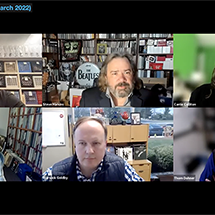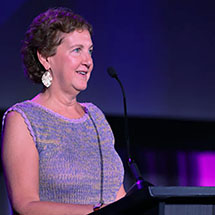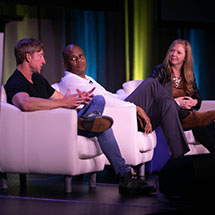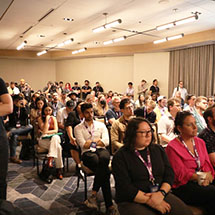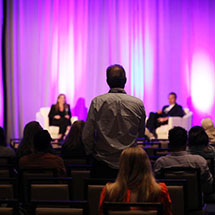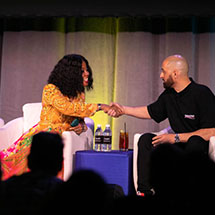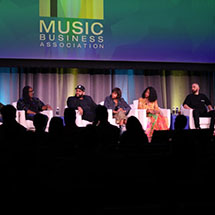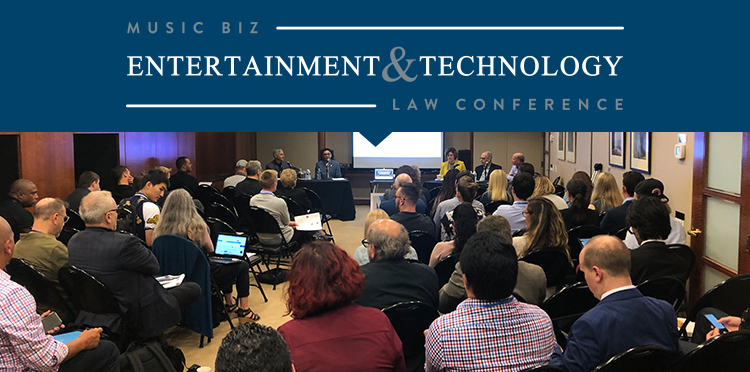
Copyright Infringement, Metadata, Podcast Licensing and More Take Center Stage at Music Biz’s NYC Law Conference

Now in its ninth year, Music Biz’s Entertainment & Technology Law Conference brought together expert voices from the tech & startup, entertainment law, and music business communities to discuss the hot button issues affecting the music business today. The event was sponsored by BMI and Greenberg Traurig, and was once again held in the New York offices of GT in the MetLife Building.
Panel 1: Blurred Lines: A Discussion of Recent Music Copyright Infringement Case Law
In his panel introduction, moderator Art Levy of The Levy Firm began by stating that “Blurred Lines” was the best possible title for this session, due to changes in how the courts review cases that have led to uncertainty into what is and is not copyright infringement. This confusion has been discussed in cases involving artists from Led Zeppelin to Katy Perry, and notably came to a head through the panel’s namesake, the “Blurred Lines” court case. Speaker Eric Osterberg, whose boutique law firm specializes in copyright protection and intellectual property, laid the groundwork to clearing up confusion around what elements of a song can actually be infringed upon, how artists can prove their songs were being unlawfully copied, and what types of compensation they can seek through the courts.
According to the law, artists must have received copyright for their work prior to filing the suit, and need to prove that their song was indeed original material that was infringed upon, beyond de minimus similarities. For example, similar ideas, clichés and standard devices, facts, song titles and short phrases are not covered by copyright law as are not easily recognized as unique ideas that are the exclusive creation of one artist. Concrete examples of compositional elements music be showcased in the deposit copy sheet music which artists submit to register their work with the Copyright Office. Infringement cases typically settle, resulting in injunctions being issued that prevent infringing material from being further distributed and financial compensation for the wronged party.
In the end, Osterberg added, it is the burden of the plaintiff in an infringement case to a jury, which can be challenging if the jurors do not have enough of a musical background to understand how the defendant’s song infringes on the plaintiff’s. Enter Judith Finell, an esteemed musicologist who was the testifying expert witness for the family of Marvin Gaye in the “Blurred Lines” case. Finell discussed how she uses analytical tools to review two pieces of music and create, as she put it, “a constellation of similarities” that clearly communicates what song elements are copied. She also discussed the challenges of testifying in such a case. During the “Blurred Lines” case, the presiding judge did not allow for clips of Gaye’s track to be played, and a key piece of evidence between the track and “Blurred Lines” could not be used because it was not found on the deposit copy.
Given that copyright cases are based on the deposit copy of a song, what solutions are available to artists who want to ensure the true vision of their song is protected? Robert Clarida of Reitler Kailas & Rosenblatt provided one example via a 1988 copyright filing for the Rolling Stones classic “Sympathy for the Devil.” The track was already filed for copyright in 1968, before a new law was enacted 10 years later that protected actual sound recordings, not just sheet music. This updated filing cited the originally granted copyright and was filed to protect new compositional elements which were not included on the original deposit copy. Clarida stated this is significant for ongoing litigation, as the U.S. government recently weighed in that this method works best for ensuring all elements of a song are protected.
The panel ended with a debate on YouTube mashups, in which users upload clips of two songs that sound similar and bring compositional similarities to light. The panel was divided on their functionality. On one hand, they do indeed showcase similarities between two songs in an easily understandable way. But, as Finell pointed out, they can also confuse juries by creating inaccurate “harmonic parallelism,” especially for mashups where the key or BPM of one track is altered. This discussion once again highlighted the importance of factual evidence that informs and does not mislead the jury. Courts are concerned with ensuring there is no chance of a reverse decision, and in order to do so, they require credible, fact-based analysis of the two compositions.
Written Materials:
- https://musicbiz.org/wp-content/uploads/2019/09/Marcus-Gray-et-al-v.-Katy-Perry-.pdf
- https://musicbiz.org/wp-content/uploads/2019/09/Pharrell-Williams-v.-Frankie-Gaye-No.-15-56880.pdf
- https://musicbiz.org/wp-content/uploads/2019/09/Skidmore-v.-Led-Zeppelin-No.-16-56057.pdf
Panel 2: (Pod)Cast Away
With ad revenues forecasted to hit $700 million in 2019, it’s clear to see why, as moderator Evan Parness of BMI put it, podcasting has become the “topic du jour” in the music business. What started as a platform that gave the everyman with a microphone the ability to broadcast their voice is now causing seismic shifts in the music landscape, as is evident with recent acquisitions and platform changes to incorporate podcasts on platforms like Spotify and Pandora. The day’s second panel discussed the questions that still remain as podcasts continue their transition from the basement to the boardroom, including how record labels can leverage the platform and how can creatives ensure that they are fairly paid when their music is featured on a podcast.
The discussion began with talk of what constitutes a podcast and differentiates it from other mediums. While it seems like a common sense answer, this analysis is important because it calls into question how content can be licensed for the platform, especially with a large community of independent creators who typically would not be able to license artists’ music for their shows on their own. Right now, shows that are supported by larger players and can afford license are a small part of the market — Atlantic Records’ Tom Mullen cited a stat that if a podcast has 848 downloads a month, that show is performing better than 80% of the current market. So how does one go about licensing music for a show they are working on? Gabriel Fleet of Greenberg Traurig responded to an audience question about such a license in saying that this issue is very similar to a synch in that it still revolves around “derivative work.”
Parness pointed out that BMI does not offer a specific “podcast license” for content they handle, which led a discussion on the current “Wild West” environment where many podcasters are not obtaining proper licenses for derivative works. Fleet attributes this to a lack of education for smaller players on licensing, and stated that larger companies are building expectations into new contracts with podcasters that they will obtain proper sign-off for content the way someone working on a film or TV show would. Stitcher, for example, asks its creators to sign a disclaimer that all licensed content in a podcast is signed off on prior to it appearing on their platform.
More gray areas emerge however when talking about deep-dive podcasts that cover specific artists or albums, playing clips of their work interlaced with commentary on the topic. Many creators claim Fair Use when interlacing their content with music which should be licensed, but as the market continues to grow, Fleet points out that Fair Use is less lenient unless the show is true journalism or an analytical work. The group also stressed that the common perception of “10-Second Rules” or “30-Second Rules” is inaccurate — there is no set time limit for content to be used under Fair Use.
So how can artists receive proper compensation when their work is used in podcasts? Fleet discussed how podcasters doing their due diligence are currently clearing songs in ways similar to a synch, but that the process still proves to be cumbersome. Perpetual licenses, for example, are great for TV synch applications, but may not make sense for podcasts with limited budgets. To address some of these problems, Richard Conlon of SoundExchange discussed the company’s partnership with SourceAudio to create a licensing marketplace that allows for podcasters to license music at reasonable rates based on number of downloads, show revenue, audience size, and other essential listener data. A beta is expected to launch next year. Another good fallback, the panel agreed, was the use of production music, which supports the independent music scene for musicians looking for odd jobs and can easily create transition or theme music specific for that podcast.
Artists, and their labels, can also get in on the action by creating their own podcasts. For example, Mullen has established Atlantic’s podcasts into a prime marketing opportunity, sitting down with the label’s artists to discuss and play clips from their latest releases as part of their promotional campaigns. This process creates promotion for the artist, content for Mullen, and captivates the attention of the audience longer than the amount of time someone would look at an online ad. Mullen offered, “If I can get someone to listen to it and they’re more invested in Cardi B or Missy Elliot, then we need to be a part of it.”
Written Materials:
- https://www.broadcastlawblog.com/2011/07/articles/beware-music-use-in-podcasts-downloads-and-on-demand-streams-are-not-covered-by-your-soundexchange-royalties/
- https://www.hypebot.com/hypebot/2019/08/soundexchange-to-power-global-podcast-music-licensing-.html
- https://medium.com/podcast-101/music-for-podcasts-myths-licences-and-what-you-need-to-know-dd5ed4506d00
- https://powerpresspodcast.com/2016/03/04/copyright-myths-that-will-sink-your-podcast/
Panel 3: Navigating the Dimensions of Metadata
As on-demand music streaming continues to drive major growth for the music business, the industry has shifted from employing full-time individuals to manually enter information from CD liner notes to tech-based solutions of logging music metadata. This is essential in keeping up with the stark increase in content added to digital platforms every day, and as the songwriting process grows more complicated in an era of collaboration, stems and sampling. Unfortunately, the quality of music metadata has not yet risen to a level that ensures accurate logging of all parties responsible for the music we consume, leading to major issues in the compensation process for creatives. Panel moderator Laurie Jakobsen of Jaybird Communications stated that the goal of perfect metadata integration is akin to installing a jacuzzi in a house, and that right now the industry, “is working on fixing the pipes before the jacuzzi can even be delivered.”
The melding of the music business and technology has opened many doors for both creatives and consumers to easily share and discover, respectively, music that may have gone by the wayside without major label promotion in decades past. However, gone is the expectation that consumers can receive specific, targeted recommendations for their favorite types of music ala speaking to a local record store guru. As UMG Special Technology Consultant Howie Singer put it, if a smart speaker user says, “I Love Glenn Campbell and I want to hear more like him,” the speaker cannot give them artists similar in genre, sound, mood, and beyond. Jakobsen added that smart speakers can only answer questions that they have answers for. If a user wants to build a playlist of songs that a certain engineer worked on, that information needs to be available, even if it is not “mission critical” transactional data that labels require.
Metadata and music credits has even affected how industry professionals find jobs in the music business. Dick Huey of Jaxsta, an Australian company set on establishing the largest online database of music credits, stated that producers used to get new jobs based on being recognized in album liner notes — this experience is gone when a listener cannot see who produced the record on a digital format. Their database solution is a welcome change for music superfans and curious industry professionals looking for the right sound for their artist. But currently, issues still arise over what version of a song should be mentioned when crediting certain stakeholders — “a big ball of string to untangle,” as Huey puts it.
So how can the industry best reorganize the metadata pipes? Recent pushes from platforms like Spotify, who recently added songwriter information to its platform, are a step in the right direction to recognizing songwriters and other stakeholders, and Jaxsta’s mission looks to go even further. On the artist end, the panel agreed that there needs to be more education that explains to artists that they should pay attention to how their audiences consume music and what data is necessary for those formats. Songtrust’s Brad Yuan offered that the priority in their conversations with artists is to navigate the blockages of money that is owed to them, but that they are beginning to discuss how proper data entry on their end can prevent said blockages. Instantaneous data entry is clearly necessary, which opened discussion on the promise of the blockchain. The group agreed that this system would help facilitate instant payments to artists based on streams as they happen, but Jakobsen pointed out that at some point there needs to be data input by a human user.
Another side to the transparency issue is how much artists can expect to earn under the current streaming model, where money is pooled and distributed on a monthly basis to artists based on how many streams they amass in comparison to other artists. There has been talk of moving to a subscriber-based system, where whatever artists a subscriber listen to in a month receive a split of their monthly membership fee. But neither this nor the current model make it easy to develop a consistent spreadsheet of what an artist will be paid that still does not create accurate representation. Joe DeCanio of Backlash Solutions said that his clients use Backlash’s software to create an accounting sheet for artists to give estimates as consistent as possible with their contracts, so they have a regular understanding of what they stand to make.
A lengthy discussion of data formats concluded the session. Given the vast variety of data needed for different online marketplaces, streaming services, and now smart speaker protocols, the industry has placed a great deal of faith in ISRC and ISWC codes from the RIAA and SESAC, respectively. Panelists remarked that the intention was for these codes to be seen as authoritative, but that has not turned out to be the case. Yuang posed that more publishers should concern themselves with ISWC codes, but the panel described wait times between four weeks to a full year to receive confirmation of registration. New metadata standards are also emerging which would implement information geared for both music commerce and user discovery experience, such as DDEX’s MEAD format. In order to best engage consumers, especially those using voice search, algorithms need to have a correct response on the first try. With something like the MEAD standard, users theoretically would remain engaged because they have less trouble finding a specific song by giving any granular piece of information they know about it. And going forward, companies like Songtrust aim to educate their artists that if their metadata is not entered right at the outset, they may miss the chance to connect with a potential new fan.
For those looking for more information on the MEAD metadata standard, Music Biz is hosting a webinar on October 10 where the DDEX team will discuss what data the format encompasses and how it aims to improve user search and discovery experiences. Click here to learn more and register.
Written Materials:
- https://medium.com/swlh/why-proper-metadata-in-music-is-so-important-7b125cc19c2f
- https://www.theverge.com/2019/5/29/18531476/music-industry-song-royalties-metadata-credit-problems
Panel 4: Charting The Future For The Stems Marketplace
Stems have emerged in recent years as a hot new commodity for labels and artists alike. Stems are broken-out components of songs — guitar parts, bass lines, vocal leads, and so on — that can be considered either “wet” (processed with effects) of “dry” (raw, not produced). Creatives can use stems in digital audio workstations as the basis for an entirely new song they are working on. Of course, as it involves the rights behind the master recording of a song, there is a major rights issue that exists even though a full sample of a song isn’t being used in the traditional sense. Right now, according to Sony Music’s Greg Norman, the label offers 27 stems, and the label considers each stem that they sell part of the “finished master work.” Universal Music Group offers bundles of stems which open natively in partner apps, according to company SVP of Business Development for Digital Strategy and Technology, Bill Gagnon.
So how do labels go about clearing permission for stems with their artists? For the majors, this involves direct conversation with the artists. UMG treats each stems bundle like a digital download, and will only offer the product to consumers with express consent from the artist. The same goes for Sony, with Norman saying that they would never release stems if it went against the artist’s vision for their work. However, there are some artist contracts with enough ambiguity with permission to break songs into stems. Norman posed that new contracts will need this end use to be more explicitly spelled out, with opt-in statements built in for the artist’s protection. Another question arises on the publishing side: if a song that is comprised of five stems, should there be one or five licenses issued for the composition? While the answer is unclear right now, both Norman and Gagnon report that Sony and UMG, respectively, obtained separate copyrights and ISRC numbers for each song stem they offer. And Mohnish Sani of Kobalt Music Group stated that because stems are available to the consumer just like full songs are, there must be rights in both the complete composition and the song itself. So, if there is a revenue share on the label side, there should be something similar on the publishing side as well.
JJ Rosen of Splice was on hand to discuss how his company is looking to do “what iTunes did for songs to the samples marketplace.” Splice offers a $7.99 monthly royalty-free marketplace with preexisting samples sourced from sample labels and from sound designers creating their own samples. Users receive 100 credits a month, and samples ranging from a hand clap to a drum hit cost one credit apiece. The company views stems as a subset of music samples, and looking to the future, they have plans to revolutionize that market as well. Splice is working with content creators to create song components longer than their typical sample — think a bass line or drum beat as opposed to a hand clap or a “Yeah.” To showcase the power this marketplace yields, Rosen said the company is working with select producers to create songs based on these new stems. This trial and sample song project is expected to go on through the end of the year, with hopes of creating a full public marketplace in the future. Rosen offered that to date, Splice has paid $20 million to its partnered sample creators, and the payouts are increasing. “Every time something like this is used,” Rosen offered, “money going into the pockets of creators.” He also presented the case of producer Boi-1da, who this year won a GRAMMY and was nominated for five others, for tracks which used three Splice samples. So not only do the creators who submit stems or samples get paid, but they allow other creatives to push their art into new boundaries.
How will the major labels respond as stems become a more prominent consumer offering? There was marked excitement from both Norman and Gagnon for this market’s potential, even though as Gagnon said the industry is still playing the short game with stems for the time being. “We have a class of people who are manipulating sounds that are quickly becoming proficient at it,” Gagnon said, adding that the desire for stems will only lead the market to grow. Norman offered that the opinion of artists and other stakeholders may change as new technology to manipulate stems releases, and as new use cases for the format are developed. Another potential opportunity is to break up catalog content into its own stem marketplace. This, however, poses a challenge because it requires access to masters to create quality stem products. The panel agreed that artificial intelligence may also be a great way to help split tracks into stems in the near future. These developments echo similarities to the rise of karaoke, where artists initially were concerned with having lesser, rerecorded or generic sounding versions of their songs out in public. Fast forward to today, and karaoke apps are ubiquitous and have created a healthy new revenue stream for artists.
At that point, moderator Gary Greenstein of Wilson Sonsini Goodrich & Rosati reached out to the artist managers and lawyers in the audience for their perspectives on stems. Based on the reaction, opinions are still mixed — some love the idea of engaging fans and creators alike in an opportunity to use their songs to create, while others feel it devalues their compositions. Norman stressed that the current quality of stems and the technology to mix does not allow common consumers to easily make and illegally distribute remixes of songs, and that there is still plenty of uses for stems that are “not nefarious.” Splice offered that in the future, companies like his can serve as a “synch licensing intermediary,” which would host stems on its marketplace and sell the rights to stems to consumers at a premium. After it has been available for some time, the company would assess the splits with the label to see how they are performing, using this data to build a better marketplace that benefits Splice, the label, and their artist.
Written Materials:
- https://musicbiz.org/wp-content/uploads/2019/09/DJ-REPORT-Updated-1.pdf
- https://www.rollingstone.com/politics/politics-lists/songs-on-trial-12-landmark-music-copyright-cases-166396/de-la-soul-vs-the-turtles-1991-61686/
Panel 5: Blurrier Lines: The Evolving and Confusing Landscape of Data Privacy and Cybersecurity in the Entertainment Industry
At the advent of the internet in the 1990s, the common belief was that “Content is King,” and that it would be the major source of revenue on the platform as it continued to grow. Fast forward two decades later, and as moderator Barry Perlman of Ritholz Levy Fields LLP put it, it seems that “Data is King.” Consumer data has become a hot commodity that helps companies more easily target specific audiences, ensuring greater returns on their marketing efforts. However, there is great risk in collecting and storing consumer data, as an attack from a hacker can expose highly sensitive personal and financial information for a company’s customers and, ultimately, lead to distrust in said company. The day’s final panel touched on how consumer privacy and cybersecurity are handled in the entertainment industry, including best practices from overseeing government bodies, and how changes both overseas and stateside are leading to a renewed focus on protecting the consumer.
Perlman began the discussion reviewing the major entities established to handle consumer data privacy. Right now in the United States, there is no uniform, omnibus federal privacy law — instead, data privacy has remained a states’ rights issue and nationwide protection exists via a “patchwork” of state regulations. The closest thing to federally governing bodies with regard to entertainment law are the Federal Trade Commission (FTC) and the Children’s Online Privacy Protection Act (COPPA), and even these have their issues in their current forms. As consumer privacy expert Katherine Lewis of Meister Seelig & Fein LLP explained, the FTC operates to protect both consumers and commercial entities from one another, which means there are instances the Commission has to rule against a consumer if it inhibits a company’s ability to do business. However as the use of technology both in commerce and on the consumer side began to grow rapidly, the FTC in 2012 issued new “best practices” (linked here) for companies to follow, ensuring they are best serving consumers and protecting their business interests. Companies operating in the U.S. were expected to update their Privacy Policies to match these guidelines, but doing so retroactively without informing consumers is considered deceptive to the general public.
Of course, a company saying they will enforce a new privacy policy and actually enacting it are two separate things. In recent months, major tech companies have faced unprecedented fines, Lewis explains, to set a standard all companies must follow. In response, governments across the globe are starting to take charge by creating their own guidelines to regulate big tech and ensure the enforcement of data privacy — notable examples mentioned were the General Data Protection Regulation (GDPR) in the EU and the California Consumer Privacy Act of 2018 (CCPA). Panelist Craig Besnoy, whose law practice specializes in intellectual property, technology and privacy, offered that as these conversations are happening, it is of utmost important for media attorneys to get a seat at the table up-front, to help lead the discussion about how companies can best implement privacy by design practices. Based on the FTC’s guideline of privacy by design, this could mean that suggesting to companies that they only collect data essential to their operations, so they are not questioned as to why they have collected information outside their scope if a data incident occurs. Or, the panel postulated, this could mean obtaining broader data collection rights up front so they can adapt to new formats or products that would require them to ask permission for more data in the future. The FTC is asking companies to be proactive, as they are stewards of incredibly sensitive data, and operating to protect data not only saves necessary legal repercussions but, as Lewis put it, “engenders consumer trust and increased goodwill.”
So what happens in the event of a data breach, which the panel agreed to refer to as a “data incident?” Each state in the U.S. has breach notification laws in place, and many have their own statutory framework which may affect data protection and the use of data by private entities. As mentioned earlier, California is working to pass an updated privacy-focused legislation, the CCPA; New York State, Delaware and Maryland are also preparing stronger laws in response to consumer concerns to events such as last year’s Cambridge Analytica incident. These new laws would grant consumers the right to access what information a company has collected since they have begun interacting, and the option to “opt out of sale” of their personal data to outside parties. Brittany Bacon of Hunton Andrews Kurth LLP points out that bills like the CCPA, which was drafted in a week’s time, are a start, but do not completely ensure consumer protection just yet. There is also work on a federal privacy bill, something the major tech companies want; however this has proven tricky to hash out because it involves consensus across all 50 states. A nationwide bill also requires proper communication to all parties involved — legislators, legal teams, companies and consumers — something which the EU is facing now with the GDPR. U.S.-based companies who do business in the EU, for example, are currently working on understanding the law by asking legal experts how this directly affects them. While the GDPR is written for companies based in the EU and those outside companies targeting EU consumers, it is essential for companies in the U.S. to comply with the cross-border guidelines set up by the law. If an artist from the U.S. is touring in the EU, for example, and the marketing team collects data during the tour that they’d like to bring back to the U.S., they are required to be proactive approach in collecting and securing that information.
After laying the groundwork for what constitutes a data incident and how regulations are responding to consumer threats, the discussion moved to how companies can ensure the data they collect is safe. This started with talking about insider company threats — Perlman offered that this is not the issue of a company’s IT department, but rather that it comes down to proper employee training on what could create vulnerabilities for the company. It is also important to educate employees on new types of cybercrimes, such as “spear phishing,” which subverts the expectations of an employee by using email addresses and names of parties they trust to mine for data (rather than receiving a message from “the Prince of Nairobi,” hackers are, say, able to mimic an artist’s manager via email to gain access to data, contract information, or money.) Ransomeware attacks are another new threat, where hackers use a ransomware program to access company’s files and demand money to release them. Besnoy says that the best way to handle a ransomware attack is to not pay for a company’s own files; rather, the best way to subvert an attack is to properly backup data, completely wipe all memory and complete a full restore from backup. Company reaction to a data incident is also crucial, as a proper and prompt reaction is key to getting ahead of handling the problem and, of course, the public’s perception of the company’s competency. Companies must have a common understanding on how to respond to serious threats, never downplay the severity of the crisis, and of course never deny that something is happening. In examples of some incidents the panelists have helped clients through, feigning ignorance was always the worst possible solution. This tied a bow on the underlying theme of the panel: a company’s best response to any data-related issues is a combination of proactive preparation and meaningful reaction that demonstrates an understanding of how this affects stakeholders outside their offices — namely, the consumer.
Written Materials:
- https://www.bakerlaw.com/USConsumerPrivacyandtheCCPA
- https://www.forbes.com/sites/williamhochberg/2019/05/28/tough-data-privacy-laws-could-cool-the-music-business–and-lead-us-to-a-new-beatles/#17a594506eed
- https://musically.com/2019/01/21/spotify-and-apple-music-among-firms-targeted-by-gdpr-complaints/
Thank you to all who attended and spoke at this year’s NYC Law Conference — and special thanks to BMI and Greenberg Traurig for supporting the event! Our next Entertainment & Technology Law Conference will take place during Music Biz 2020, set for May 11-14, 2020 at the JW Marriott Nashville!

